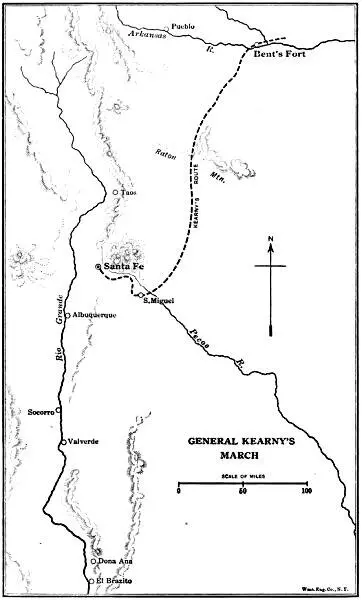At St. Louis, Missouri, the New Mexican situation was doubtless fairly well understood, and a deep interest in the caravan business existed. The merchants, it was felt when the war became probable, deserved to be protected, and many urged the prompt despatch of an expedition for that purpose. Other arguments for such a step were, that it would forestall Indian troubles on the border, would incline the enemy—by laying open their weak side—to make terms, would encourage the people of New Mexico to rise in our favor, and would secure the key to Chihuahua and California; and in all probability influential men brought these ideas to the President’s notice.4
The occupation of Santa Fe was in fact decided upon as one of the very earliest war measures—primarily for the sake of the traders, but also with a view to the permanent retention of the province. The move was intended to be pacific, however. Polk doubtless expected that no serious opposition, if any at all, would be offered by the people; and there seem to have been hopes that Chihuahua and her sister states could be persuaded by arguments backed with force to let the caravan trade go on despite the war. In that case the burdensome duties imposed at Santa Fe would no longer have had to be paid, and the discrimination in favor of Mexican competitors, that had prevailed there, would have ceased. On May 13, therefore, the governor of Missouri was directed to raise eight companies of mounted troops and two of light artillery for an expedition to New Mexico, and Colonel S. W. Kearny of the First Dragoons was directed to command them.4
So fine an opportunity for adventure appealed instantly to the bold, hardy and energetic young fellows of Missouri, and as early as June 6 volunteers were hurrying into the service at Fort Leavenworth—a square of wooden buildings, with a blockhouse at each corner and a plot of grass in the middle—which crowned a high bluff on the Missouri River about 312 miles from St. Louis; and about 1660 troops were soon assembled at that point. Of Kearny’s dragoons there were some 300. The First Regiment of Missouri Mounted Volunteers—which chose Alexander W. Doniphan as colonel—numbered about 860. The artillery, including nearly 250 men, consisted of “Battery A” of St. Louis under Captain Weightman and a company under Captain Fischer, a graduate of the Prussian artillery service, and formed a battalion commanded by Major M. L. Clark, a West Pointer.3 There were also two small companies of volunteer infantry, a St. Louis mounted body of about one hundred called the Laclede Rangers, which Kearny attached to his regulars, about fifty Delaware and Shawnee Indians, and finally, though by no means last in importance, a Roman Catholic priest familiar with the Spanish language.4

Without lingering to complete the outfit, Kearny sent the command off by sections. June 5 a detachment of the dragoons advanced. By the twenty-eighth all of Doniphan’s regiment were on the march for Santa Fe and—none of them cared how much farther; and two days later Weightman’s fine brass cannon, gleaming radiantly in the bright sunshine, wheeled into the trail. For several days the troops had to break their way through a rough country, but about fifteen miles south of the Kansas River they struck the Santa Fe road, a broad, well marked, natural highway running toward the southwest.6
Council Grove, the famous rendezvous of Indians and frontiersmen, was the last place from which a single person could safely return; and now for nearly four weeks not one “stick of timber” was to cheer the eye. After pressing on in the same direction to the Arkansas, the troops left the main trail, marched wearily along the northern bank of the river—ascending about seven feet in each mile—till they were beyond the great bend, and finally, crossing the shallow stream, turned their faces toward Bent’s Fort, a protected trading post, which stood near the present site of Las Animas, Colorado, about 650 miles from Fort Leavenworth. Belts had been tightened over and over again by this time. Drinking water that no horse would touch had sickened many a tough rider. Mosquitos and buffalo gnats had tormented the flesh day and night. Faces had been scorched by siroccos, and tongues had swollen with thirst. Many had become so tired that a rattlesnake in the blanket seemed hardly worth minding, and so utterly wretched that in blind fury they sometimes raved and cursed like maniacs. Out of one hundred fine horses belonging to Battery A sixty had perished. Yet in places there had been cool breezes, carpets of brilliant and spicy flowers, great herds of buffalo, curious mirages, and inspiring glimpses of Pike’s Peak, the towering outpost of the Rockies.6
At length on July 29 Kearny escorted by Doniphan’s regiment gained the rendezvous, a grassy meadow on the Arkansas about nine miles below the Fort. There within a few days the Army of the West assembled,5 and two additional companies of the dragoons, which had made an average of twenty-eight miles a day from Fort Leavenworth, joined their regiment. Nor were the troops alone. Several merchants had left Independence about the first of May. Notified by order of the government that war had begun, they had stopped here; and the Colonel found under his protection more than four hundred wagons and merchandise worth upwards of a million.6
Armijo, for his part, had received ample warnings. In March the central government informed him that war might be expected, and authorized him to make preparations for defence. By June 17 news of the coming invasion reached Santa Fe, and nine days later the first caravan of the season confirmed it. Manuel Alvarez, the American consul, endeavored now to persuade Armijo that it would “be better for himself and the people under his government to capitulate, and far preferable” to become Americans than to be citizens of a country so disordered and so impotent as Mexico; but while his advisers and subordinates fancied they could obtain offices under an elective system, and “were rather easily won over,” the governor himself probably could not believe that people so long robbed and oppressed would choose the wolf as their shepherd. Besides, he doubtless had some national spirit and some desire to justify his gratuitous title of general. After confirming the news further by a spy, he sent south on July 1 an appeal for aid—representing the Americans as 6000 in number—and began to prepare for defence. A letter from Ugarte, the comandante general of Chihuahua, stating that he could set out on a moment’s notice with five hundred cavalry and as many infantry, seemed encouraging, and no doubt Armijo was aware that Durango, too, had been ordered by the authorities at Mexico to aid him.7
Meanwhile reinforcements for Kearny were gathering in his rear. On the third of June Marcy informed the governor of Missouri that if Sterling Price, then a member of the Missouri legislature, and certain other citizens of the state would raise and organize a thousand mounted men—that is to say, a regiment and a battalion—to follow Kearny promptly, they would be appointed to the chief commands. This method of getting troops aroused considerable opposition among the people, for it ignored the militia system and the aspirations of the militia officers, and many felt that a politician like Price was unfit for the command; but young men were ready to volunteer under any sort of conditions that promised a chance to reach the front, and about the time Kearny left Fort Bent this new force, including artillery under regular officers, was mustered into the service at Fort Leavenworth.8
At the same time steps were taken to obtain reinforcements of a totally different character. A large number of Mormons, recently driven from Nauvoo, Illinois, had gathered at Council Bluffs, and were planning to settle in California. It was important that feelings of hostility toward this country should not prevail among them, and apparently their assistance, not only on the coast but in New Mexico, might be valuable. Kearny was therefore authorized to accept a body of these emigrants not larger than a quarter of his entire force, and about five hundred of them were enlisted in June and taken to Fort Leavenworth by Captain Allen of the First Dragoons. Allen soon died, but under Lieutenant Smith of the same regiment this party marched for Santa Fe.8
Читать дальше













